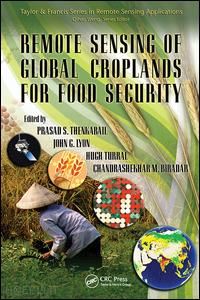Background and History of Global Irrigated Area Maps (GIAM)Context, Need: The Need and Scope for Mapping Global Irrigated and Rain-Fed AreasHugh Turral, Prasad S. Thenkabail, John G. Lyon, andChandrashekhar M. BiradarA History of Irrigated Areas of the WorldY.J. Li, Prasad S. Thenkabail, Chandrashekhar M. Biradar, Praveen Noojipady, Venkateswarlu Dheeravath, Manohar Velpuri, Obi Reddy P. Gangalakunta, and Xueliang L. CaiGlobal Irrigated Area Mapping (GIAM) Using Remote SensingGlobal Irrigated Area Maps (GIAM) and Statistics Using Remote SensingPrasad S. Thenkabail, Chandrashekhar M. Biradar, Praveen Noojipady, Venkateswarlu Dheeravath, MuraliKrishna Gumma, Y.J. Li, Manohar Velpuri, and Obi Reddy P. GangalakuntaGIAM Mapping Section for Selected Global RegionsUncertainty of Estimating Irrigated Areas in ChinaSongcai You, Shunbao Liao, Suchuang Di, and Ye YuanIrrigated Areas of India Derived from Satellite Sensors and National Statistics: A Way Forward from GIAM ExperienceObi Reddy P. Gangalakunta, Venkateswarlu Dheeravath, Prasad S. Thenkabail, G. Chandrakantha, Chandrashekhar M. Biradar, Praveen Noojipady, Manohar Velpuri, and Maji Amal KumarMapping Irrigated Lands across the United States Using MODIS Satellite ImageryJesslyn F. Brown, Susan Maxwell, and Shariar PervezUse of Remote Sensing to Map Irrigated Agriculture in Areas Overlying the Ogallala Aquifer, United StatesBethany Kurz and Santhosh SeelanAssessing the Extent of Urban Irrigated Areas in the United StatesCristina Milesi, Christopher D. Elvidge, and Ramakrishna R. NemaniThe Challenges of Mapping Irrigated Areas in a Temperate Climate: Experiences from EnglandJerry W. Knox, S.A.M. Shamal, E.K. Weatherhead, and J.A. Rodriguez-DiazIrrigated Area Mapping in the CWANA Region and Its Use in Spatial Applications for Land Use Planning, Poverty Mapping, and Water Resources ManagementEddy De PauwSubpixel Mapping of Rice Paddy Fields over Asia Using MODIS Time SeriesWataru Takeuchi and Yoshifumi YasuokaEvapotranspiration Models, Water Use, and Irrigated AreasAssessment of Water Resources and Demands of Agriculture in the Semiarid Middle EastRoland A. Geerken, Ronald B. Smith, Z. Masri, and Eddy De PauwEstimating Actual Evapotranspiration from Irrigated Fields Using a Simplified Surface Energy Balance ApproachGabriel B. Senay, Michael E. Budde, James P. Verdin, and James RowlandSatellite-Based Assessment of Agricultural Water Consumption, Irrigation Performance, and Water Productivity in a Large Irrigation System in PakistanMobin-ud-Din Ahmad, Hugh Turral, Aamir Nazeer, and Asghar HussainRain-Fed Cropland Areas of the WorldGlobal Map of Rainfed Cropland Areas (GMRCA) and Statistics Using Remote SensingChandrashekhar M. Biradar, Prasad S. Thenkabail, Praveen Noojipady, Y.J. Li, Venkateswarlu Dheeravath, Manohar Velpuri, Hugh Turral, Xueliang L. Cai, MuraliKrishna Gumma, Obi Reddy P. Gangalakunta, Mitchell A. Schull, Ranjith D. Alankara, Sarath Gunasinghe, and Xiangming XiaoMethods of Mapping Croplands Using Remote SensingMultiangle Spectral Measurements: A Way to Distinguish Cropping AreasFrancis CanisiusApplying Pattern Recognition to Satellite Data for Detecting Irrigated Lands: A Case Study for Georgia, United StatesVijendra K. Boken, Gerrit Hoogenboom, and Gregory L. EassonMapping Irrigated Crops from Landsat ETM + Imagery for Heterogeneous Cropping Systems in PakistanM.S.D.N. Gamage, Mobin-ud-Din Ahmad, and Hugh TurralAccuracies and ErrorsAccuracy and Error Analysis of Global and Local Maps: Lessons Learned and Future ConsiderationsRussell G. CongaltonWay Forward in Mapping Global Irrigated and Rain-Fed CroplandsRemote Sensing of Global Croplands for Food Security: Way ForwardPrasad S. Thenkabail and John G. Lyon











